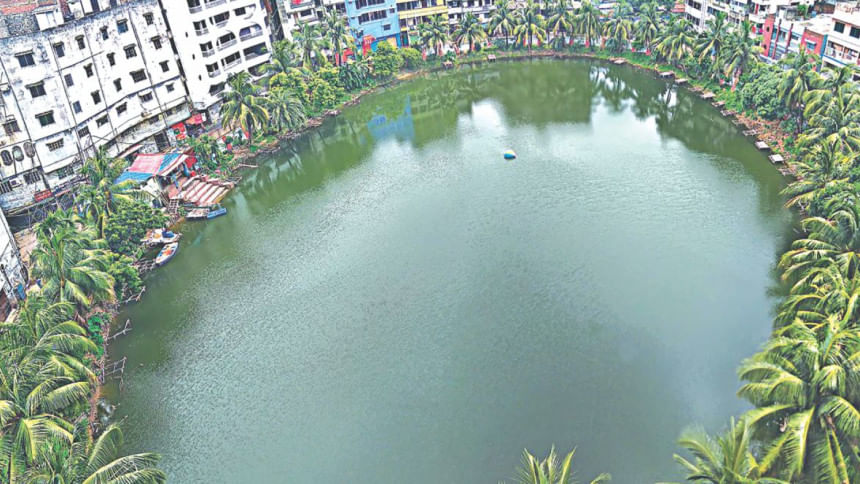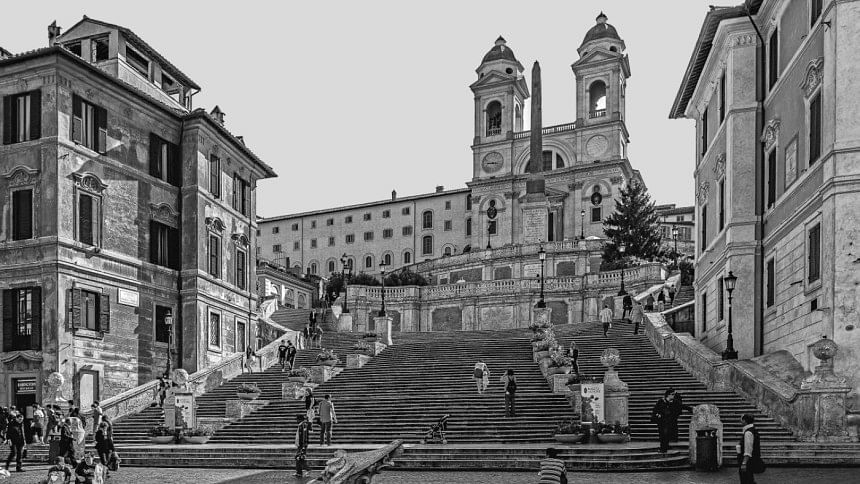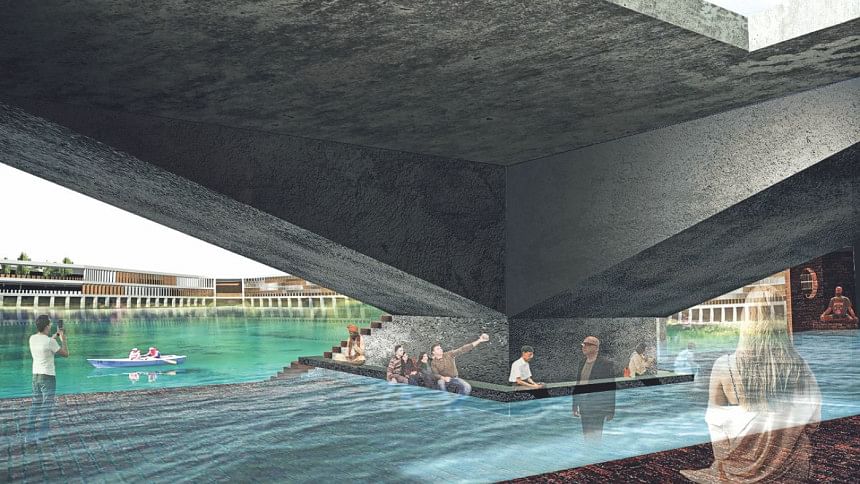Ethics needs esthetics: Beyond the architecture of good intentions

In the past fifty years, Dhaka has transformed itself from a sleepy provincial centre left over by the British Raj, unchanged through its years as East Pakistan, into one of the world's burgeoning megalopolises and can boast of being paradigmatic of the many threats human settlement poses to the environment world over.
High levels of air and water pollution threaten everyone and the poor state of public space makes everyone wish to escape from it: into the climatised privacy of the house, of the car, of fancy resorts abroad, and dreams of outer space, if that were an option! The global neglect of public space is a symptom and a result of economies driven by an ever-accelerating catch-as-catch-can. Is this course of affairs irreversible—must we tolerate this degraded state of urban life?

Though everyone today is aware of the need for change, the rising pile of statistics, reports, warnings and preaching does not seem to significantly shift private or public behaviour. Looking at history it seems that there are two key drivers of change: one is the intense experience of pain—which is unacceptable—and the other is the promise or experience of pleasure—a far better approach! It is the latter driver of change that we chose to instigate at a workshop held at the invitation of the Bengal Institute for Architecture, Landscapes and Settlements in Dhaka in March 2019.
The two critical questions of this particular workshop were: what kind of public space in Dhaka would be for the benefit of all? And what kind of instruments do architects need in order to create good architecture? The second is crucial too, because the architecture of good intentions is not necessarily also good architecture. Bad architecture gets demolished, and is therefore a waste of resources.
Water: Dhaka's much neglected resource
Public spaces have the chance to become essential for the cultural identity and pride of a city when they respond to its natural resources, e.g. its topographical features, as well as to local traditions and trends. They should even celebrate these features by architectural means. This is the case with the magnificent public stairs such as the "Spanish Steps" in Rome which turn the slopes of the hills into places of relaxation, thereby becoming the contemplative counterparts to the busy squares at their foots and tops. This is also the case with the hot springs in Budapest which Roman, Muslim, Habsburgian and Ungarian rulers subsequently turned into public spaces functioning for the benefit of all up to today. And it could become the case with the remaining rivers and lakes in Dhaka.
Water is the great natural and potential architectural resource of Dhaka. But as Md Khalequzzaman, a professor of geology at Lockhaven University, recently pointed out: "The Asian Development Bank reported that the quality of rivers in Bangladesh is the worst among 48 Pan-Pacific countries. Dhaka is surrounded by four rivers, which could be a source of drinking water as well as a source for recreation and trade. However, because of the poor water quality, the water is unsafe even for physical contact" (The Daily Star, March 11, 2019). The pathetic bad smelling, disease laden waters that residents of Dhaka have come to know are in stark contrast to the powerful life-giving and life-affirming waters of Bengali lore and poetic culture. It might even seem like a blessing when the putrid water bodies get buried under expanded real estate developments which are but so many nails in the coffin of the natural environment of the city. But designing against nature is short-sighted.
In order to turn awareness towards the preciousness of water we let the students first design some posters. The posters are composed of collages and slogans. The collages show a few iconic architectural spaces we had analysed earlier in the seminar but now appeared flooded with water and with slogans such as "Water is Gold" or "Water is terrific. Water terrifies." These point out that water cannot be ignored.

Learning from Gol Talab
The recognition of water as a public resource was not always as poor as today, and an outstanding remnant of these bygone days must be the Gol Talab in Islampur. Its water allows significant biodiversity and is clean enough to swim in—the pond being maintained by its residents, by the Moulvi Khawaja Abdullah Welfare Trust and the Bangladesh Water Development Board. And it is a beautiful space: an ellipse surrounded by trees, a walkway and buildings, all of them redrawing the elliptical shape of the pond. This consonance of elements theatrically embellishes nature and turns nature into something more than the merely found but rather into an asset and both a generator of urban form and a focus of public space.
The executed plans for Hatirjheel Lake however fall short of the lesson given by Gol Talab: the lake is surrounded by expressways and thereby exposes the waterfront to pollution and noise as well as making it inaccessible. Token shrubbery and occasional benches on the slope do not provide much relief to the public. To develop a viable concept for Dhaka lakes and lakefronts, we chose a triangular part of Hatirjheel lake which is circumscribed on two sides by the Moghbazar-Flyover and its branches and on the third side by the railroad line leading to Kamalapur Station. Actually, the first two sides, the noisy ones, are fenced in with shrubbery but no human access, while the third side is gentler but with a harsh and bare slope to the water. The next question is: What kind of programming, i.e. public use and enjoyment, could turn this portion of the lake into a space of recreation for the whole neighbourhood and the public at large?
Discussing traditional and trendy habits in Dhaka with the students, we concluded that the water body itself should be reserved for bathing and swimming: no sailing, washing clothes or bathing animals. Yet bathing alone does not make up for prolonged recreation. It is merely an episode in the drama of recreation, it is a ritual which has to be intermingled by other activities on land. Therefore, the lakefront should offer sports facilities and cafés, book-trading posts and salons to make music in or debate, areas for playing chess or watching movies. Activities which usually take place behind closed doors and in separated locations should be brought together on the lakeside in order to enliven the space for the people of today who aim at balancing contemplation, communication and physical activity in their leisure time.

Lakeside-shelves and Ghatscapes
To protect the lake from noise, a sound-barrier as high as the flyover has to be erected. This sound-barrier should be conceived as a space-containing, building-like wall solid towards the street and open towards the lake. On its floors all the above-mentioned activities can be stacked and collocated logically: the noisy part in the west-wing exposed to the morning sun, the quiet part in the east-wing exposed to the evening sun. A parcour along the lake connects all parts, the back holds the serving spaces, the rooftop offers jogging-and-biking tracks and urban farming for the nearby-residents. In this way the wall turns into a shelf which allows replacement and re-combination of the recreational and cultural uses according to the changing demands of society.
On the southern side however, urban shelves are not an option because their front would be exposed to the north. Here another question became central: Should the borderline between water and land be fixed or blurred? Do we need hard or soft edges, slopes or steps, platforms or caves, basins or islands? We decided that we need them all. The Bengali form of the ghat serves as the motivic cell from which a landscape of discovery starts. The southern side will be a piece of playful and communicative landscape-architecture; it will be a new, unprecedented ghatscape.
And this exuberant ghatscape finds its echo in the ground floor of the lakeside shelves. Here water enters the ground floor, plays around the columns, enters caves, the little waves licking the steps of the platforms. In between the columns of the west-wing the ghatscape even literally gets repeated in smaller scale, becoming a playground for the younger ones and inspiring them to cross the lake and discover space on their own. The dramatic culmination of this trialogue of water, land and space however is the cave in the apex of the triangle: a 15 m high waterfall—directly inspired by one of the collages mentioned before—dominates a mysterious space, nevertheless also having the mundane task of a sound-barrier between the noisy and the quiet wing and even sending its roar to the street. Altogether these structures turn the lake into a theatrical setting: the ghatscape becoming the audience, the lake the stage and the shelves the backdrop. They form a public space as intense in its interiority as the ones conceived by the Romans.

Architecture as Drama
Good architecture unfolds its qualities in time like a piece of music or like a drama. It has to be experienced and it needs the right dosage of consistency and surprise. People of today, we said, want to balance a wide range of activities—therefore they need spaces composed of polarities. In his book The Drama of Space Professor Kleine argues that all architecture is experienced as a drama and that there are four fundamental types of architectural dramas: the one of finality (such as a sacred spaces which make you search for the right spot to attend the prayer), the one of circularity (such as museums which make you walk through a sequence of spaces), the one of transitoriality (such as a traffic hub which makes you move from A to B) and the one of polarity (such as schools where you rhythmically switch from places of concentration to places of relaxation). It goes without saying that in a particular project the dominant type should be challenged and enriched by the insertion of episodes of other types in it.
Our design is structured by the polarities in potential purpose and use of water vs land, of quiet vs noisy, of contemplative vs communicative. Setting such polarities turns the site into a space where one can spend longer periods of time. But our design does not stop with these programmatic concerns but carries the principle of polarity through all those parameters which make up the richness of architectural spaces. In terms of water-space, there is the open lake coming into view immediately but there are also some hidden caves which can only be adumbrated in the beginning, and some of the caves are small pocket-spaces and others big halls, and some shape the sunlight and others filter it, and some are serene and some are sublime or mysterious in their character … In other words: the timing of what comes into view at what point, the balance of surprise and consistency, the modulation of light, the subtle change of atmosphere and the brusque change of scale and the displacement of activities and many others are not just accidental side-effects but indispensable features of good architecture. They have to be carefully considered from the beginning on in the planning process.
All architecture students and professors all over the world today use the Architect's Data of Ernst Neufert (first published in 1936, and since then reedited in uncountable editions). It is a brilliant book for the pragmatic side of architecture but one which completely ignores the poetic potential of its material. Therefore, it is only a necessary but not a sufficient bias in order to create good architecture. The Drama of Space (Birkhauser 2018) supplements Neufert by demonstrating the taxonomies and principles underlying the poetics of architecture. Books never replace individual inspiration but they help reflecting consequences and suggesting improvements. The enthusiasm of the students and the results of the only two-week long workshop at the Bengal Institute proved the manageability of the prolific principles laid out in The Drama of Space.
Chaos + Order = Beauty
Dhaka does not have the means to reinvent its urban space in the radical ways as Baron Haussmann did for Paris in the 19th century or Shah Abbas for Isfahan before that. But space containing walls are minimal and yet powerful surgical interventions in amorphous cityscapes because their order and strict horizon transform the all too chaotic urban forms into picturesque backdrops. That is the visual effect of the Procuratie on St. Mark's Square in Venice, of Central Park West in New York and of Fort Lalbagh in Dhaka. Why not make the formula of Chaos + Order = Beauty a guiding principle? Our project is neither meant to be a single event nor to be a utopian fancy. It is a vision for a particular spot based on a new urban type adaptable to other places. The lakeside shelves or, more general, urban shelves as well as the ghatscapes can be realised in stages and varied and extended for uncountable other locations in the 20-million-city. In order to redirect the flow of capital one has to raise collective enthusiasm and weld alliances. The Bengal Film Studios for example are situated next to "our" lake and they should be part of the story that unfolds at the Hatirjheel lake. A film museum, a cinema and more could be mounted on the lakeside shelves. The realisation of our vision would only be a beginning for a greater Dhaka but a powerful one. But, patience!—the stair-scapes of Rome weren't built in a day either.
Timmy Aziz is Professor of Architectural Design at MICA, Baltimore, USA, [email protected].
Holger Kleine is Professor of Design of Public Interior Space at HSRM, Wiesbaden, Germany, holger.kleine@hs-rm.de





Comments